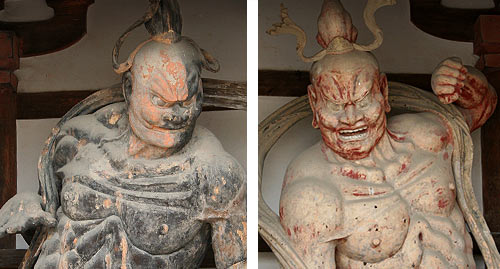| Sk: a-hum.
'A' is the sound of the first letter of the Sanskrit alphabet and
is pronounced with the mouth open. 'Un' is the sound of the last
letter of the Sanskrit alphabet and is pronounced with the mouth closed.
At the entrance to a Shinto shrine, there are often two lion-dog shrine
guardians *komainu
¢, one with mouth open and the other with mouth closed. *Niou
m¤ (two kings) guardian figures are found at either side of a Buddhist
temple gate, in the same poses. 'A' and 'un' represent the
beginning and the end of all things, or inhalation and exhalation, respectively.
The expression with the mouth open is known as *agyou
¢` and that with mouth closed as ungyou Ý`. Examples include the
stucco Niou from 711 guarding the central gate *Chuumon å of Houryuuji
@² in Nara. The right-hand figure (when facing the gate) has the agyou
expression, and the left-hand figure the ungyou expression. Another
example of an a un pair are Japan's largest Niou (wood, 8.03m), guarding
the *Nandaimon ìåå at Toudaiji å in Nara, made by Unkei ^c (?-1223) in the Kamakura
period. |



